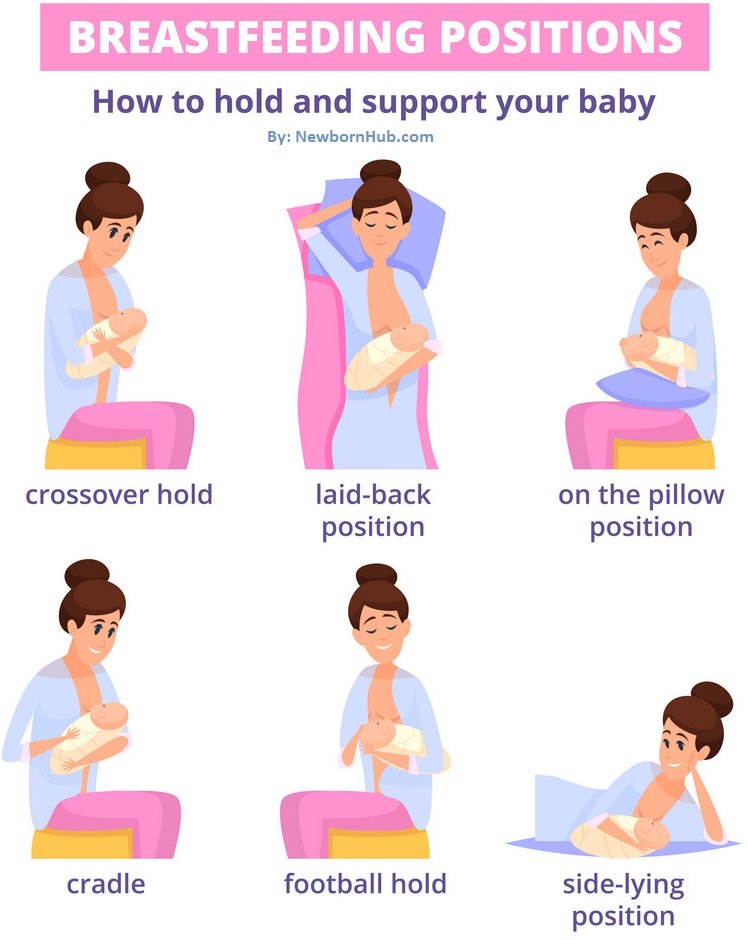- HOME
- Breastfeeding
How to Breastfeed a Newborn?
Here's all you need to know!
It is natural for new parents, specially moms, to worry about how to breastfeed a newborn. And while you struggle to visualize how on earth are you going to squeeze in your boob in that super tiny mouth, you may get overwhelmed by the feeling that there is a lot to learn. However, it is so simple that you will be amazed. And in no time, both you and your baby will be getting the hang of it naturally while you relax, sleep, read, or do anything!
In this section:
- What Happens Right after Birth?
- How Early can I Start?
- 4 Simple Steps on How to Breastfeed a Newborn
- Latching On
- Breastfeeding Positions
- What is a Let-down Reflex?
- How Often Should I Breastfeed my Baby?
- Is my Baby Getting Enough Milk?
- What to do if my Baby keeps on Falling Asleep during Feed?
- How do I Increase My Breast Milk Supply?
- Resuming Work while Breastfeeding
- Foods to Eat while Breastfeeding
- Foods to Avoid when Breastfeeding
- How to treat Sore Nipples?
What happens right after birth?
As soon as you give birth, your breasts start to fill up. Initially, your breasts produce Colostrum which is more like an appetizer for your baby – but it is the real deal. This pre-milk secretion is different than the regular milk that the breasts produce moving forward. For some mothers, the Colostrum is yellowish and thick, while some mothers find it to have a thinner and watery consistency.
The Colostrum is slowly secreted by your breasts which enables your baby to slowly start feeding naturally (this is as new for your baby as it is for you, so hang on there). You will notice that the Colostrum will be automatically replaced by the real breast milk in around 2 to 4 days.
When should I start breastfeeding my newborn baby?
In about 1 to 2 hours after birth, your newborn baby will need his/ her first meal. By that time your breasts have also produced ample Colostrum for the initial feed. Here is what you need to do:
- Before each feeding time, you need to wash your hands with soap. You will be touching your breasts, nipples, your baby’s mouth, etc. with your hands especially during the initial days when trying to teach the little one to latch on. So you need to have super clean hands. It is also a good idea to wipe your breasts after each feeding or before each feeding so the milk residue on your breasts is cleaned.
- Pick a breastfeeding position that feels the most comfortable (look at the picture here for help). Don’t worry, mothers experiment with the best feeding position in the initial few days (or sometimes weeks). Go for a breastfeeding position that is comfortable for you and your baby.
- With one hand/ arm, you will be supporting the baby or yourself to give your baby the proper position. With the other (free) hand, put the thumb on top of your breast and the rest of the fingers below it to hold that breast. Now touch your baby’s lips with your nipple. Your baby will smell the milk and feel the breast touching his lips and will gradually open his mouth.
- Once your baby has opened his mouth as wide as possible, place your entire nipple inside his mouth (not just the tip of the nipple, otherwise you will feel the tiny gums chewing the sensitive nipple). The darker part of skin around the nipple needs to go inside his mouth so that his soft jaws can activate the milk ducts present under the areola.
For most of the new mothers, this is the trickiest part. They wonder how they can squeeze their big breast inside such a tiny mouth. But you do not need to put half the breast inside his mouth, nor do you need to put the tip of the nipple.
How to tell if my newborn has correctly latched on?
When your baby has properly latched on, his lips would pout and should cover almost the entire areola. As he starts to suck, his jaws should move back and forth with every sucking motion. When he swallows, you may hear soft pitched swallowing sound (and not a smacking sound). In this whole process, if your nipples feel pain, it could be a sign that the baby has not latched on properly and you need to try again.
Some new mothers worry that their breasts may block the tiny nose from breathing. While you may notice that your baby’s nose may touch your breasts during the nursing process, this tiny nose is naturally designed to let the oxygen in and out. If you are worried that the baby is having difficulty breathing and latching on at the same time, you can gently push the area of your breast that touches the nose, allowing him more room to breathe. Make sure your newborn baby does not have to strain his tiny neck or head during nursing.
Breastfeeding positions: How to hold your baby while breastfeeding?
When learning how to breastfeed a newborn, the positioning plays an important role. There are many ways you can hold your baby in while breastfeeding as long as both you and your baby find the process comfortable. Some of the most loved positions by feeding mothers are:
- Cradle Position: Hold your baby with one arm with the baby’s head resting comfortably in the crook of your arm and the rest of the baby’s body (the back and the bottom) on your forearm. This way, your baby will be facing you and hence your breast will be right in front of your baby’s mouth.
- Side-lying Style: This position is often opted by moms who had a C-section, but you and your baby can also love this position even if you had a normal delivery. For this, lie down and let your baby lie down next to you while facing towards you. Pull your baby close so the baby can get in contact with your breast. If you want, you can use a pillow to adjust and make this situation more comfortable. Just make sure you don’t fall asleep while feeding your baby as it could lead to a dangerous scenario and increases the risk of SIDS – Sudden Infant Death Syndrome. You need to consider the risks in mind if you are thinking about co-sleeping with your baby.
- Football Position: Supporting your baby’s body with your forearm, rest the tiny head in your hand, and tuck the body of your baby under your arm. Make sure your baby is facing you. This is a great position for mothers who have large breasts, have had twins/ triplets, or had a C-section.
- Cross-cradle Position: This position is especially great for premature babies as well as for those babies whose sucking abilities are not very strong. Here you can hold your baby with the opposite arm for the breast you are using. For example, if you are feeding with your left breast, hold your baby in your right arm and vice versa. Make sure the head of your baby is supported by your palm and the tiny body is supported by your forearm. The baby must be lying facing you. The additional head support provides more stability to your baby while he or she latches on.
The “Let-down Reflex”
As you start to breastfeed your baby, you may feel a tingly sensation in your breast and nipple (sometimes in both even when your baby is latching on to one of them). This sensation is the result of milk flowing and for this reason, sometimes milk drips from the breast which is not in use. The “Let-down Reflex” may occur when your feeding is overdue, when you think about your baby, or when your body is creating too much milk as compared to the amount consumed by your baby.
Sometimes when your baby is latching on, this Let-down Reflex can create a large volume of milk that can make your baby cough (the rate of milk secretion is more than what your baby can swallow). In such cases, you can squeeze some milk by pressing your fingers around the nipple and discharge it before letting your baby latch on.
How many times a day should I breastfeed my baby?
As many times as the baby wants!
Right after birth, you may need to feed your baby around 8 to 12 times a day, and sometimes even more. This number can change – sometimes decreasing while at times increasing as your baby grows. Babies are said to demand more milk than usual when they are around 2 to 6 weeks old and again around 3 months and 6 months of age as they grow at a rapid pace.
Babies generally cry when they are hungry, but newborn babies may be too sleeping to ask for milk until they are really hungry. Do not wait for your baby to cry their lungs out before latching on as this will make the process of latching a bit harder – they may be too upset by then. Your baby exhibits some early signs to show that he or she is hungry.
When you don’t get the hint, then the crying starts! Here are some signs to look for:
- When your baby makes a sucking motion during sleep.
- When your baby starts opening his/ her mouth while moving towards your breast as soon as you pick him/ her up.
- When the baby starts to put their hand/ fist in their mouth (and starts to suck their hand).
- When your baby responds to sounds and motions more than he/ she normally does. This is a sign they are alert and excited while waiting for the milk truck to arrive!
Let your baby drink milk until the baby is full and satisfied. The baby will let go of your breast once the tummy is full. The feeding time is usually 15 to 20 minutes per breast. Make sure you empty one breast before moving on to the next one. This will make sure your breast continues to produce milk at a good pace. Some mothers use alternate breasts in each sitting. The problem with that is that after 20 minutes the breast starts getting empty and the baby only sucks without getting ample milk.
You need to make sure that your baby uses both breasts in each sitting and finishes up one breast before moving to the second one. This way, both the breasts will be empty and ready to produce more milk by the time of the next feeding session. If the breasts are not completely empty, they will decrease the milk production which may cause pain and swelling. You can use a cold compress before starting the feeding to take care of the pain and discomfort.
How to know if my baby is getting enough breast milk?
Look out for the signs of a full tummy and a satisfied baby. Consider the following checklist to see if your baby is getting enough milk:
- Your baby wets 6 to 8 diapers per day.
- The baby passes around 2 to 5 stools daily. This is the initial count. As the baby grows, the number of stools may decrease to once or twice a day.
- After each feeding, the baby is not cranky and shows signs of satisfaction (which means no suckling hand or opening his/ her mouth near your breasts when you hold him/ her).
- Starts gaining a little weight (though your baby may lose some weight in his/ her first week after birth which is normally around his/ her initial 3 – 7 days).
How to breastfeed a newborn when he/she keeps on falling asleep?
Wake your baby by gently rubbing your nipple alongside his/ her lips. Gently stroke his/ her cheeks, jaws, and chin area with your fingers. It is natural for babies to fall asleep during breastfeeding, but if you do not wake them up to finish off the feeding, they will demand milk from time to time. This will not just make them cranky but will also ruin your breast’s milk production cycle.
Sometimes baby sleeps during nursing when the breast gets empty. Try offering the other breast and squeeze some milk on his/ her lips. This will make them start nursing again. It is natural for the babies to fall asleep once their tummy is full. If you have been feeding them for half an hour and have used both your breasts, they may be full and satisfied.
How do I increase my breast milk supply?
It is a simple demand-supply thing. The more you feed, the more milk will your body produce. Increase the number of feeding sessions and make sure each breast is empty before moving onto the other breast. You can tell when your breast is empty by feeling it with your fingers. A breast filled with breast milk is hard and round while an empty breast feels soft and wobbly.
You can also increase your breast milk by drinking plenty of water, resting well, and eating healthy food. Make sure you understand what foods to eat when breastfeeding and the foods you need to avoid during breastfeeding.
Some mothers introduce solids before their baby turns 6 months old in fear of the baby feeling hungry. When you introduce formula milk or introduce cereals during breastfeeding before your baby is 6 months old, you only make it harder for your breasts. Your baby may lose interest in breast milk which means your breast will decrease in their milk production.
If you are worried about how to breastfeed a newborn when you are experiencing a low milk production dilemma, click here to know more about increasing your breast milk and the home remedies that you can try out from your kitchen pantry.

How to breastfeed a newborn and resume work at the same time?
So before you know it, your maternity leave is over. Getting back to the office does not mean depriving your baby of the goodness of your breast milk. You can breastfeed your baby before leaving for work. While at work, you can pump your milk in a private space and store the milk safely. Click here to learn about the ways you can express and store your breast milk.
You can ask the baby’s caregiver to give this stored milk the next day while you are at work. You can refrigerate your breast milk for 4 days and can even freeze it for 6 to 12 months! When you are back home from work, breastfeed your child like you normally do. This way your baby can have breast milk and you do not have to worry about any pain, discomfort, or low milk supply.
Foods to avoid when breastfeeding
Almost whatever you consume goes to your baby via your breast milk. There are various foods and drinks you need to avoid or at least minimize while breastfeeding your baby. On the other hand, there are some foods you must eat to provide better nutrition to your baby. Click here to know more about the foods you need to avoid as well as those you need to eat while breastfeeding.
What should I do if I get sore nipples?
How to breastfeed a newborn when the nipples hurt and bleed? As they say, prevention is better than cure. Instead of treating sore nipples, it is better to prevent having them in the first place. One of the main reasons why your nipples get sore when you breastfeed is because your baby does not latch on properly. To release suction during the feed, insert your finger in the corner of your baby’s mouth. Now switch to the other breast, but this time, push the area around the nipple in your baby’s mouth. Your baby should have pout lips while sucking and the lips should cover the majority of the darker skin area around the nipples – the areola.
Remember, if breastfeeding hurts or your nipples bleed, it could be because your baby is holding onto the nipple and not the area around it. Make sure your baby’s mouth is in the right position.
To heal the cracked nipples:
- Squeeze some of your breast milk with your fingers and apply the milk around your nipples and let it dry. It is a natural way to cure sore nipples.
- If your baby has to feed, give your baby the nipple that is less sore out of the two. When your baby starts to breastfeed, the baby sucks harder the first few times, and then when the milk starts flowing naturally, the baby needs to suck with less force.
- You can also squeeze a couple of drops of milk using your fingers to discharge some milk until the let-down reflex occurs. Then offer the breast to your baby.
- Wash your nipples with lukewarm water and do not use soap or any perfume based lotion or body wash as they can end up drying the skin more.
- Keep your nipples dry by changing bra and bra pads.
- To soothe your nipples, you can rub lanolin on them.
Click here for more info on treating cracked nipples.
If you feel pain due to breast engorgement, or find a red sore spot on your breast, you should call your doctor. Furthermore, contact your doctor if you get a fever or feel body ache without any specific reason when you are breastfeeding. There is no rocket science in how to breastfeed a newborn. Like all other breastfeeding mothers, you will soon get the hang of it. Until then, we are here to help!
See also:
- Common breastfeeding problems and their solutions
- How to increase your breast milk?
- Breastfeeding tips
- What foods to eat (or avoid) when breastfeeding?
- Reasons not to breastfeed?
- How to pump and store your breast milk?
- Why should you breastfeed?
- Benefits of breastfeeding for mothers
- Breastfeeding vs bottle feeding
- How long should you breastfeed for?
Return from Breastfeeding section to Homepage.
Take part in our Poll - and see if you share the same views as other parents.





New! Comments
Have something to say about what you just read? Leave me a comment in the box below :)